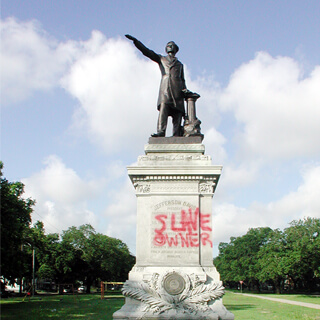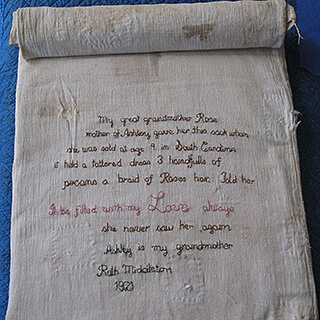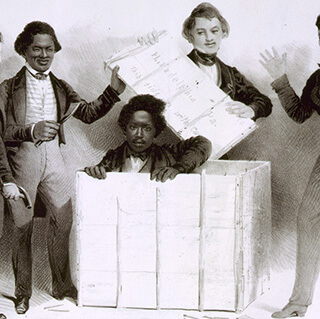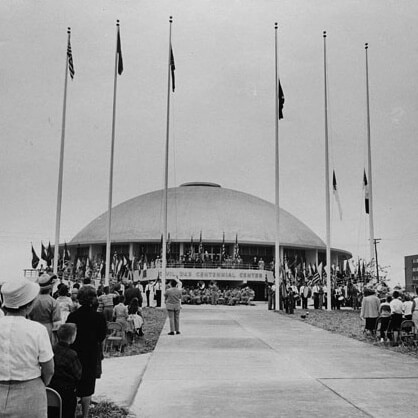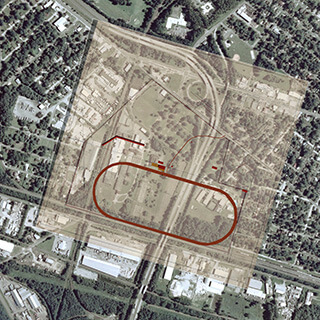Overview
William A. Blair reads the inscriptions on the headstones in Section 27 of Arlington National Cemetery for insights into the lives of African Americans at Arlington and other plantations in the Upper South before and after the Civil War. Excerpted from Civil War Places: Seeing the Conflict through the Eyes of Its Leading Historians edited by Gary W. Gallagher and J. Matthew Gallman. Photos copyright © 2019 by Will Gallagher. Used by permission of the University of North Carolina Press.
Essay

The tours that I lead at Arlington National Cemetery begin here. We are standing in Section 27, a location in the northeastern corner of the cemetery bordered by the wall to our right that separates this hallowed ground from the Marine Corps Memorial, popularly known as the Iwo Jima Monument. This is a silent corner of the cemetery, far from the tourists who stream up the hill to the Kennedy gravesite and the Arlington House. Breaking the contemplative quiet are the occasional maintenance vehicles that keep the cemetery pristine, as well as the Netherlands Carillon next door that tolls the time in Big Ben fashion. But the headstones make the greatest impression as they sweep up, then down, and then up again along the rolling terrain. Puzzling to a newcomer are the words "citizen" and "civilian" on the headstones in what is supposed to be a military cemetery. Yet they tell a story central to Arlington and mirror an even larger story of black Americans who lived through the transitions from slavery to segregation.
Here rest roughly 3,800 people whose individual stories likely will never be reclaimed and whose actions during a crucial moment in our past shaped the definition of freedom. Many of the headstones contain no name. The situation frustrates me because, whether the bodies have been identified or not, the people within these grounds did not leave records that allow doing justice to their memory. We know only that they were African Americans who died in the vicinity of Washington. More can be teased out of the military records of another 1,500 who fought with the US Colored Troops and who also lie in this section. But we cannot learn much about Samuel Anderson, "Citizen," or what brought him here. We can merely situate him within a broader movement of people who either fled the bonds of slavery or struck out on their own as free blacks to seize a greater range of choices opened by the Civil War. Section 27 evokes a past containing the experiences of the enslaved who lived here, the contrabands who congregated during the war here, and the emancipated citizens who earned their subsistence until evicted from here. This sweep of black history at Arlington from 1802 to 1900 even offers surprises: a sister-in-law of Robert E. Lee was a freed slave who lived most of her life on what is now patriotic ground.

Although I do appreciate the cemetery for its wider purpose, I cannot help but recognize that the place owes its existence to a slave plantation founded in 1802 by George Washington Parke Custis. It has been common to say that he built the mansion that sits on the heights overlooking the Potomac River and Washington, but this labor was accomplished primarily by his slaves. Custis inherited them from his natural grandmother the widowed Martha Dandridge Custis, whose second husband was George Washington. The father of the nation also became the adoptive father of Custis, giving him parental advice that betrayed exasperation over the lackadaisical manner in which the boy pursued his studies. With bequests from the Mount Vernon estate, which included nearly 200 slaves spread across three plantations, Custis lived a fairly comfortable life.
Most contemporaries considered Custis an indulgent master, an assessment that both acknowledged him as a good person and criticized him as a loose manager. He does not seem to have been overly harsh, yet even this judgment must be tempered by the reality of life under a master-slave relation. At least half a dozen slaves ran away from Arlington over the years before he died in 1857. And there was an incident with an overseer on one of Custis's three plantations (not Arlington) in which slaves may have been drowned, although the person accused claimed it was nothing more than accidental. Whatever the truth, the master of Arlington does not seem to have been culpable.
He also was a leader in the American Colonization Society, a movement considered to be progressive at the time. The assumption was that white and black people could not live together, that freedom for the enslaved necessitated voluntary relocation to countries like Liberia. This was about as far as progressive Virginians could go without adopting the radical policy of widespread abolition. Here again, Custis was typical of slave owners in arguing for colonization not from recognition of the humanity of his charges but as an effort for white people to avoid being overwhelmed by an ever-increasing, and potentially hostile, black population.1The African Repository, and Colonial Journal 3 (February 1828): 356–60. His belief in this effort allowed for the immigration of one of his enslaved families to Liberia—William and Rosabella Burke, who sent letters about their experience to Mary Custis Lee, the wife of the future Confederate general. Contemporaries and historians have noticed the affection that was shown to Mary in the letters from former slaves. This appeared to be heartfelt and represents one side of a complicated relationship in which white people considered black people as property while living in a world in which master and slave confronted each other personally.


The other side of this master-slave relationship lies in the story of Maria Syphax, one of the more famous former slaves on the Arlington plantation/cemetery. In 1826, Custis freed Syphax and her family and gave them seventeen acres of ground on the plantation. He had also hosted her marriage with Charles Syphax, a household slave, in the Arlington mansion—a rare occurrence. It turns out that Custis had fathered Maria with Ariana Carter, a household slave of his mother at Mount Vernon. The US Congress in 1866 recognized Maria's claim to the property, granted out of Custis's "paternal instinct," in legislation that allowed her to live out her life on the grounds until her death in 1886.2Boston Daily Advertiser, May 19, 1866; Lowell Daily Citizen and News, May 22, 1866; US Statutes at Large, 39th Cong., 1st Sess. (Washington, DC, 1866), 589–90. The illegitimate birth resulted from a relationship we can scarcely reconstruct, but even if it contained tenderness on the part of the slave it occurred within a power relation difficult to separate from sexual molestation. It was a common situation throughout the antebellum South. Thomas Jefferson may be the most famous transgressor with Sally Hemings, but he had company. Historians place the number of mulattoes in the South at between 10 and 12 percent in 1860, although the product of mixed-race unions constituted more significant proportions of city dwellers: 39 percent of free blacks and 20 percent of slaves. These were the numbers reported in a society that publicly frowned upon amalgamation of the races. There were certainly more mixed-race offspring than appear in the record.3Robert William Fogel and Stanley L. Engerman, Time on the Cross: The Economics of American Negro Slavery, 2 vols. (Boston, MA: Little, Brown, 1974), 1:132; James Ford Rhodes, History of the United States from the Compromise of 1850 to the McKinley-Bryan Campaign of 1896, new ed. (New York: Macmillan, 1920), 340. See also Population of the United States in 1860, Compiled from the Original Returns of the Eighth Census (Washington: Government Printing Office, 1864), x. The union made Maria the half-sister of Custis's only surviving white child, Mary, who became the wife of Robert Edward Lee in a ceremony at Arlington in 1831.
Often away on military duties, Lee reentered the Arlington picture in 1857 with the death of his father-in-law. Custis left the duties of executor of his estate to Lee, who confronted a situation that required him to act like a typical Southern planter. Custis had amassed enormous debt and left the responsibility of sorting out the family's fortunes to his son-in-law. This was not an easy task. Custis had not only stretched his finances but also promised his heirs more proceeds than the estate could fulfill. At the same time, his will ordered that the slaves who constituted the labor force, and main asset beyond land, be freed in five years. Although we do not know for certain if this happened, some of Custis's slaves contended that he told them they would be freed immediately upon his death. Remaining in slavery angered them, as did being driven harder by the departed master's son-in-law to recoup losses. Not surprisingly, some ran away, setting up an inevitable confrontation.
In recent decades the story of these runaways has grown in the scholarly literature on Lee, which depicts him as supervising the whipping of three recaptured fugitives from Arlington. The account rests upon the testimony of former slave Wesley Norris in 1866, but the story appeared before the war in Northern newspapers. Lee administered punishment to slaves as many of his class did—by using a third party. The punished included the sister and cousin of Norris, who said that Lee also ordered the whipper to wash their scars in brine to enhance the pain. After the war, Lee privately called the report untrue but did not refute the allegation publicly. Historians today accept the account as accurate in the larger details.4John W. Blassingame, ed., Slave Testimony: Two Centuries of Letters, Speeches, Interviews, and Autobiographies (Baton Rouge: Louisiana State University Press, 1977), 467–68. For the best analysis of this instance, see Elizabeth Brown Pryor, Reading the Man: A Portrait of Robert E. Lee through His Private Letters (New York: Viking, 2007), 269–72.

Because of these stories, Arlington has provided a terrific site for me to convey to touring groups, which have included schoolteachers, that this place features elements very common to slave plantations in the Upper South. Here we encounter runaways, mixed-race offspring, whippings to enforce order, kindness toward slaves, harshness toward them, crushing debt, frustration on the part of the masters and the enslaved, paternalistic ideals by white people, experiments with the colonization movement, and the fact that the columned Arlington House that we admire today exists because of laborers who had little choice other than to build it. None of this was extraordinary.
The Civil War changed the equation and ushered in an era when formerly enslaved people, in conjunction with US military forces, created on these grounds one of the more successful government-supported programs for black people in US history.5For a good study of the evolution of Arlington through Freedman's Village, cemetery, and beyond, see Micki McElya, The Politics of Mourning: Death and Honor in Arlington National Cemetery (Cambridge, MA: Harvard University Press, 2016).
As the war came to Washington, so did the contrabands. The term was coined by Major General Benjamin F. Butler for slaves escaping from masters and reaching Union hands. As a way to circumvent the Fugitive Slave Law, Butler defined fugitives as contraband because they allowed whites to go to war while black labor produced the matériel to conduct it. Particularly after Congress banned slavery in the District of Columbia in April 1862, contrabands from Maryland and Virginia flowed to the nation's capital. And they kept coming until they overflowed the camps in the city, causing cramped conditions and diseases that claimed the lives of many. Someone who witnessed this firsthand was Harriet Jacobs, a famous escaped slave whose story gained renewed interest during the war. She was among the many who saw the need for greater relief in the Alexandria and Washington area.
The chief quartermaster of Washington looked over the river for a solution and chose Arlington to relocate these refugees. Founded in May 1863, the Freedman's Village was intended to be a temporary way station to teach freed people self-sufficiency. The government also used the labor of able-bodied men and women to support the operation. While providing workers with ten dollars per month plus rations and living space, the army taxed them five dollars per month to be put toward a contraband fund for the support of people too young, too old, or too infirm to labor. By January 1864, dwellings had been constructed along with a church, hospital, and home for the aged—all aligned on well laid-out streets with a park in the center. Workshops included blacksmiths, wheelwrights, carpenters, tailors, and shoemakers. But the larger concern was agriculture, with the villagers in their first season producing 200 tons of hay and 191 tons of corn fodder, as well as potatoes and other vegetables.

Conflict, nonetheless, existed that showed that African Americans would follow their own minds and, when necessary, resort to collective protest. Danforth B. Nichols, a civilian superintendent of the village appointed by the army, angered many who considered him overly restrictive and abusive. Former slaves testified that he drank and treated them unkindly. One slave indicated, "Mr. Nichols was not kind to the people under him in the camp; he used to knock them about and kick them right smart." He added, "I can not tell the number of persons he used to abuse, but there were a great many."6Ira Berlin et al., eds., Freedom: A Documentary History of Emancipation, 1861–1867, ser. 1, vol. 2, The Wartime Genesis of Free Labor: The Upper South (New York: Cambridge University Press, 1993), 295. Matters improved little when Nichols was replaced by a military officer in the Quartermaster Department. African Americans petitioned to higher authorities for redress. They also protested the manipulation of rents, or one to three dollars per month charged on top of the contraband fund. The pushback led army officials to consider the experiment a failure and, after the war, to try to disband the village.
But the village endured. By 1865, it had come under control of the Freedmen's Bureau, a government-funded agency run by the military to aid the transition of slaves to freedom. In 1868, an effort to shut down the village was launched. Black people resisted, aided by the fact that Northerners did not mind the delicious irony of black people prospering on the property of General Lee, whose leadership had caused so many Union deaths. Four years earlier, the grounds also had become a national cemetery, with Quartermaster General Montgomery C. Meigs determined to bury bodies as close to Arlington House as possible to discourage the Lees from returning. By 1888, 170 families (nearly 800 individuals) were still living in the village.

The village did not exist in isolation but nourished black activism as part of the greater Alexandria County community. As the war ended, villagers and community blacks petitioned for the right to vote. By the summer of 1867, because of Radical Reconstruction, most black males in Alexandria County were voting Republican. Arlington estate straddled two of Alexandria County's three districts, giving the Freedman's Village political clout at the local level. Blacks held council seats, the county treasurer's office, the county clerk's office, and more.7Joseph P. Reidy, "'Coming from the Shadow of the Past': The Transition from Slavery to Freedom at Freedmen's Village, 1863–1900," Virginia Magazine of History and Biography 95, no. 4 (October 1987): 403–28. This led to an effort in 1888 by Democrats to break this power by purging villagers from the voting rolls, claiming that living on a military reservation did not make them residents of the state of Virginia. Despite their activism, black people could not control the burial of their race at Arlington. Leaders like Frederick Douglass bristled at the segregation, asserting that black soldiers should lie with the white heroes of the Union. But this area became known as the "lower cemetery," which all understood to mean the colored section.
Development pressure coupled with the political climate that turned against African Americans spelled the demise of the Freedman's Village.8Reidy makes this most sensible conclusion, situating the demise of the village within a broader context. The cemetery needed to expand, and the village lay in the southeast area of the grounds. Prime property. A government study calculated what residents had put into their homes and came up with the figure of $75,000 to reimburse them. This compensation came in 1900 as the villagers were evicted and the buildings torn down. Today, not a trace of the village remains.
Such are some of the stories that wash over me as I stand in Section 27, a place that allows for discussion of a wide range of black history that engages with the Civil War. It bothers me that there are no signs that can inform visitors who lie here, although I am the first to admit that something done without proper thought could mar the sanctity of the spot and the cemetery in general. It is not an easy solution. It also saddens me that we will never know the personal stories of the people whose headstones appear before us. Many undoubtedly improved their lives; some likely died disappointed. The fact that these graves exist testifies to the determination of a people who tried to change their lives. They seized a moment, for good or for ill.

And their headstones have left behind a comment that undoubtedly was unintentional. "Citizen" was adopted by bureaucrats to distinguish these dead from soldiers, and nothing more. But the historian in me cannot help but note an ironic statement being made. In 1857, the US Supreme Court declared in the Dred Scott decision that people of sub-Saharan African descent were not citizens. It pleases me to see a word carved on the stone of Samuel Anderson, a stone that lies in a US government facility, that declares otherwise. 
About the Author
William A. Blair is the Walter L. and Helen P. Ferree Professor of American History and the director of the George and Ann Richards Civil War Era Center at the Pennsylvania State University. His research centers on the making of Confederate identity during the Civil War and the use of ceremonies such as Memorial Days and Emancipation Days after the war to construct political identities.
Cover Image Attribution:
Arlington National Cemetery Grave Sites, Arlington, Virginia, July 2017. Photograph by Will Gallagher. © Will Gallagher.Recommended Resources
Text
Dunbar, Erica Armstrong. Never Caught: The Washingtons' Relentless Pursuit of Their Runaway Slave, Ona Judge. New York: Atria Books, 2017.
McElya, Micki. The Politics of Mourning: Death and Honor in Arlington National Cemetery. Cambridge, MA: Harvard University Press, 2016.
Morgan, Edmund S. American Slavery, American Freedom: The Ordeal of Colonial Virginia. New York: W. W. Norton & Company, Inc., 2003.
Pryor, Elizabeth Brown. Reading the Man: A Portrait of Robert E. Lee Through His Private Letters. New York: Viking, 2007.
Rainville, Lynn. Hidden History: African American Cemeteries in Central Virginia. Charlottesville: University of Virginia Press, 2014.
Web
Fortin, Jacey. "What Robert E. Lee Wrote to The Times About Slavery in 1858." New York Times. August 18, 2017. https://www.nytimes.com/2017/08/18/us/robert-e-lee-slaves.html.
Liebertz, John. A Guide to the African American Heritage of Arlington County, Virginia. Arlington, VA: Department of Community Planning, Housing, and Development and the Historic Preservation Program, 2016. https://projects.arlingtonva.us/wp-content/uploads/sites/31/2016/09/A-Guide-to-the-African-American-Heritage-of-Arlington-County-Virginia.pdf.
Poole, Robert M. "How Arlington National Cemetery Came to Be." Smithsonian Magazine. November 2009. https://www.smithsonianmag.com/history/how-arlington-national-cemetery-came-to-be-145147007/.
Similar Publications
| 1. | The African Repository, and Colonial Journal 3 (February 1828): 356–60. |
|---|---|
| 2. | Boston Daily Advertiser, May 19, 1866; Lowell Daily Citizen and News, May 22, 1866; US Statutes at Large, 39th Cong., 1st Sess. (Washington, DC, 1866), 589–90. |
| 3. | Robert William Fogel and Stanley L. Engerman, Time on the Cross: The Economics of American Negro Slavery, 2 vols. (Boston, MA: Little, Brown, 1974), 1:132; James Ford Rhodes, History of the United States from the Compromise of 1850 to the McKinley-Bryan Campaign of 1896, new ed. (New York: Macmillan, 1920), 340. See also Population of the United States in 1860, Compiled from the Original Returns of the Eighth Census (Washington: Government Printing Office, 1864), x. |
| 4. | John W. Blassingame, ed., Slave Testimony: Two Centuries of Letters, Speeches, Interviews, and Autobiographies (Baton Rouge: Louisiana State University Press, 1977), 467–68. For the best analysis of this instance, see Elizabeth Brown Pryor, Reading the Man: A Portrait of Robert E. Lee through His Private Letters (New York: Viking, 2007), 269–72. |
| 5. | For a good study of the evolution of Arlington through Freedman's Village, cemetery, and beyond, see Micki McElya, The Politics of Mourning: Death and Honor in Arlington National Cemetery (Cambridge, MA: Harvard University Press, 2016). |
| 6. | Ira Berlin et al., eds., Freedom: A Documentary History of Emancipation, 1861–1867, ser. 1, vol. 2, The Wartime Genesis of Free Labor: The Upper South (New York: Cambridge University Press, 1993), 295. |
| 7. | Joseph P. Reidy, "'Coming from the Shadow of the Past': The Transition from Slavery to Freedom at Freedmen's Village, 1863–1900," Virginia Magazine of History and Biography 95, no. 4 (October 1987): 403–28. |
| 8. | Reidy makes this most sensible conclusion, situating the demise of the village within a broader context. |

